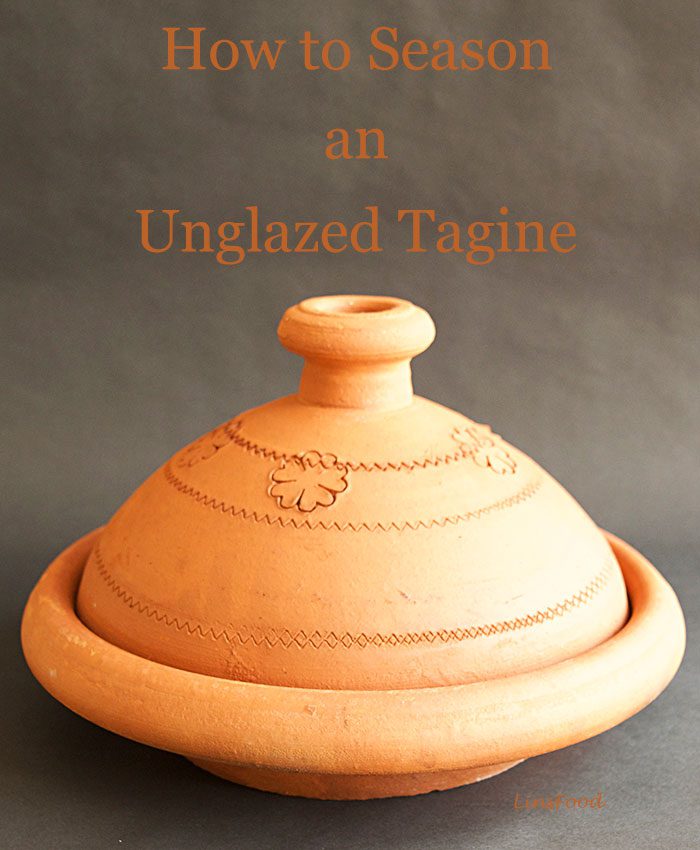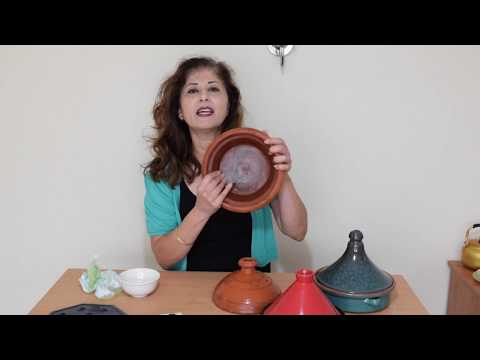
So you’ve come back from holiday with a tagine! What’s next? How do you season that brand new, unglazed tagine and then, how do you look after your tagine?
Stick with me and you’ll soon be a pro!
Estimated reading time: 3 minutes
Table of contents

What is a Tagine?
For those who might be wondering, a tagine is a cooking pot with that conical lid, synonymous with the cooking of North Africa, and for many, Morocco. The word tagine, or tajine in French, refers to both the cooking pot as well as the recipe that’s cooked in it.
Many of my students are always a little apprehensive when they attend their first Moroccan or Tagine Masterclass with me. They come as much for the recipes as to overcome their fear of cooking with claypots.
Suffice it to say, there is no magic involved, all that you need to master cooking with clay, is to understand and remember a few basic rules.
If you enjoy the video, don’t forget to LIKE the video on YouTube! Thank you! And subscribe if you fancy an exotic collection of recipes! ♥ Lin
How to Cook with Tagines
- Tagines ( and other clay pots) hate sudden change in temperatures. So don’t cook on a high heat and if cooking in an oven, always start with a cold oven. That means, place your tagine in the oven, then turn the oven on.
- Always season your unglazed tagine before first using it (our topic of the day!).
A glazed tagine doesn’t need seasoning, but you must still follow the cooking rules. Always read the manufacturer’s instructions, because some glazed tagines are just for serving in, not for cooking. - Always use a diffuser when cooking with a tagine. That means, place the diffuser on the hob, then place your tagine on the diffuser. A diffuser spreads (diffuses) the heat, so that it is not concentrated on one spot, resulting in a cracked tagine.
- Never use washing up liquid when cleaning your unglazed tagine. It is porous and will absorb anything you “feed” it. Just use a scourer and if necessary, some bicarbonate soda and scrub. If there are stubborn burnt bits, use the end of a spoon or a blunt knife, scrape off, then scrub and rinse.
That’s about it, super easy, right?
Now, let’s just take a look at how to do that first seasoning of your tagine, so that it’ll last you a lifetime! Video and written instructions!
Looking to buy a tagine?
This is my favourite article on the subject! Head on over to Moroccan Zest, and get tips for buying Moroccan tagines. Safa talks you through everything in her very detailed article.
Safa talks you through everything in her very detailed article.
If you like this article, don’t forget to leave me a comment and that all important, 5-star rating! Thank you!
Lin xx

How to Season and Care for Your Tagines
Ingredients
- Your tagine
- A bucket filled with room temperature water
- Extra Virgin olive oil as needed
- Kitchen paper
- An oven!
Instructions
- First thing we do is soak the tagine in a bucket of room temperature water overnight.
- The next day, lose the water and leave the tagine to dry for a couple of minutes.
- Dip the kitchen towel in the olive oil and rub the tagine all over, completely with the oil. Make sure every last bit of the tagine is covered.
- Place the tagine in a cold oven, close the door, then turn the oven on to 150˚C (300˚F).
- “Bake” the oven for 2 hours.
- Turn the oven off and leave the tagine in the oven, with the door closed, until they’ve both cooled down. An hour should suffice.
- Now, coat the inside of the tagine with more olive oil and leave aside to dry and for the clay to absorb the oil.
- That’s it, store until needed.


Your information has been most helpful. Cooked lamb shanks in my Tagine with veggies, etc. turned out fabulous. A very delighted birthday celebration from my “Test Kitchen”
I’m so pleased to hear that, Maurice. I adore lamb shanks anything!
If you’re on Instagram, I’d love to see what else you cook up, tag me if you post food stuff.
So grateful for your advice for an unglazed tagine. I’ve had two made by a good local potter but have been afraid to use them for fear of breakages and contamination. One more question: is it absolutely essntial to use olive oil? Would a good odourless vegetable oil be ok? Olive oil is not always available here and is very costly when it is. I’m
So excited to begin using a tagine! Lesley
Bought an unglazed tagine, seasoned it when I got home. Do I have to submerge in water and/or season it before each use? Thank you!
Hi Laura, no you don’t. Just do it that one time before first use. But always remember the heat rules:
On the stove, use a diffuser and cook on low-medium or medium heat.
In the oven, always place the tagine in a COLD oven, then turn it on.
Thanks a lot Azlin for all info and explanations
Regards
A pleasure. x
Thanks for your helpful video. I got my tagine pot from Morocco but never used it. As I check mine is glazed and I decided to make my tagine food with lamb on weekend. Please let me know if I need to soak it first.
Thanks
Hi Farzaneh, a pleasure. Since it’s glazed, you don’t need to soak it. But you will have to use a diffuser, to ensure that it doesn’t crack. Unless you’re using it in the oven. If you cook in the oven, place the tagine in the cold ove, then turn it on. Any claypot that is placed in a hot oven will crack from the sudden change in temperature.
Your glazed tagine will, over time, develop lines on the glaze, they look like cracks. But they are just the glaze showing signs of wear, nothing to worry about.
Hiya, I just got my unglazed tagine delivered and will follow the seasoning instructions thank you. I have an electric glass hob and have bought a diffuser. What is the best temperature to put the hob on from 1 – 9? Should I start it low and gradually raise the temperature? Thanks!
A pleasure, Paul. I would suggest not going higher than medium-low. Start at 2, then increase it to 3 after 10 minutes. If it’s not simmering after another 20 minutes, then increase it to 4. I think that’s the highest I would be willing to go. Once your tagine is simmering, take it back down to 2 and let it cook away.
Even on gas hobs, we only cook on low. We start with medium-low, then it goes right down to the lowest setting once it’s simmering.
I have a ceramic cook top what kind of diffuser should I use and where can I find one. Thank you
Hi Maureen, that’s a tough one.
I would suggest that you cook your tagine in the oven, this is the safest option for the tagine and the cooker.
While theoretically, placing a metal diffuser on the ceramic stove, should work, I’ve had a tagine crack on me once when I did this. So I don’t usually recommend it.
To cook a tagine in the oven:
1. Fill the tagine up with the ingredients, then place it in the COLD oven.
2. Then, turn the oven up to 170C/325F, and cook away.
>> Fish will need about 1 hour, chicken 2 and beef or lamb, 3-4 hours, depending on the size and cut.
Hello Maa’m,
What if our unglazed pot has no vent hole in the lid. Is it necessary to make one?
Thank you for this informative article.
Eric
Hi Eric, no you don’t need a vent hole in the lid. Your food will stay nice and moist with all that steam trapped in the tagine.
And you are very welcome.
hi thank you for this tutorial
could you clear my confusion, some blogs mention seasoning only the inside of the tagine. also should i also season the base as stated in your post. I will only be cooking in an oven
A pleasure, Kumayl. The difference lies in the type of tagine that you have. The one you see me working on here, the brown one, is completely unglazed. So no shiny parts anywhere. In this instance, you need to season every single inch of it. The seasoning builds a protective layer so liquids don’t get absorbed into the clay.
The other 2 tagines you see in the video, are glazed, they are already have a protective layer on them.
When a tagine is glazed on the outside, including the base, this is when some people advise seasoning only the inside.
I hope that clears your confusion.
The red and black tagine you see in the video, is completely glazed, so doesn’t need seasoning at all.
Anymore questions, just ask.
What happens if you don’t season it first? I already started cooking with it before I saw this!
Hi Kristine, anything that is porous has a tendency to leach both ways. So the food that you cook will be absorbed into the clay, and a little grit and dirt will also be released into your food. It’s minimal, but it does take place.
So the seasoning helps to seal the surface that touches the food. You can still seal it now. Doesn’t matter if it’s not brand new.
Do you have to season a glazed tagine
No, you don’t need to. But you must use a diffuser underneath it to prevent it from cracking.
Very helpful, thank you.
Thanks Jemima.
Many thanks, I am loving your Middle Eastern and N African posts. This is a great tutorial, now I won’t hink twice when I see an unglazed cookware!
Thank you Mel!
Thank you, this post is like an answer to my prayers! I’d like to use a tagine and also cook in real claypots but am so apprehensive. You’re right, that seems easy enough, thank you, Azlin!
A pleasure!